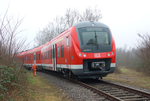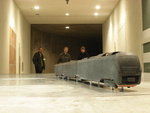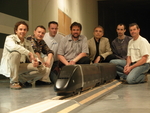Rail consultancy
It all started with the development of the Mediterranean TGV line, linking Valence and Marseilles. A line where the Mistral blows and very high embankments and bridge infrastructures are common. The risk? A possible reversal of trains… Almost ten years ago, but already, CSTB’s offer proved to be complete. On the programme: analysis of the wind at the same construction site to understand crosswinds as best as possible and to determine the aerodynamic coefficients of the moving train exposed to a side wind; climatology studies to define the average speed values related to average gust coefficients (often greater than 100 km/h); reduced-scale wind tunnel tests to best anticipate trains’ dynamic and mechanical behaviour, etc.
Upside down…
SNCF and ALSTOM Transport have become loyal clients today. Some of the most recent studies scheduled include those conducted in the Jules Verne wind tunnel. Accordingly, in 2007, CSTB worked on a life-size scale, on the bottom of the train bodies. Jean-Paul Bouchet explains, “TGVs (high-speed trains) are getting faster and faster and generate, through speed, extremely dynamic flows near the train. In other words: the ballast might take off.” A safety issue: the organs on the bottom of the train body might be damaged. “This is not really a problem for current travel speeds, but if we want our TGVs to reach 400 km/h within the next ten years, well, then, yes, we need to start worrying about it right now!”
In order to have a better understanding of these mechanisms, the CSTB’s teams recreated ten meters of railway track that were subject to air velocities likely to be found on a ballasted track, specifically through very violent gales of wind to simulate a train passing: “Our objective was to rank track treatment solutions, partial gluing, compacting of pebbles, etc., in accordance with how often the problem appeared”, states Jean-Paul Bouchet.
Another example of tests again carried out on a life-size scale: a study of the aerodynamic behaviour of pantographs, that is, the articulated arms that pick up the current on electric locomotives and are in contact with the catenary. Jean-Paul Bouchet explains, “The pantograph is positioned on dynamometric sensors that enable us to characterize aerodynamic stress. In other words, it involves checking that several types of pantograph in specific configurations behave well in the wind (drag and lift).”
From life-size scale to 1:15th
On a smaller scale (1/15th), this time we can mention the study conducted for a week for ALSTOM Transport, for the XCC regional train project (articulated self-propelled train: CORADIA Continental). This project, which is currently being developed for Deutsche Bahn AG, is a good example of work carried out very upstream between CSTB and the manufacturer. “Concretely, we have done an aerodynamic weighing of each of the vehicles recreated in the testing section – and we have done so independently but in a train situation. We have also recreated the relative winds, taking into consideration both the speed of the train and the force of the side winds.” Wind tunnel studies took five days and were followed by a week of data processing: pertinent extraction demands it.
Wind tunnel studies, numerical or on-site studies: all of the players in the railway industry are now very familiar with CSTB’s offer. The current drafting of EN 14067 standard on railway aerodynamics issues, a standard to which the French SNCF and ALSTOM Transport are contributing, is proof of this. Among other things, it determines the methods for ruling on rolling stock compliance in terms of TSIs (Technical Specifications for the Interoperability of the European rail system). Pierre Palier explains, “This is a European standardization norm between the different countries. One of the objectives is that reduced-scale tests conducted in our continent’s different laboratories be done in the same conditions and that in the end, the protocol be the same everywhere and the relevance of the results be guaranteed.” Pierre Palier and Jean-Paul Bouchet express a certain amount of pride: “The measurements carried out at CSTB will be part of the baseline data for the standardization part in terms of the effects of cross winds on railway vehicles…”



